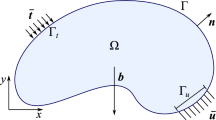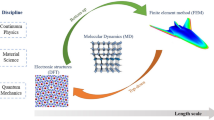Abstract
Additive printing allows the “single step” production of virtually any complex mechanical component. However, the manufacturing process involves a layer-by-layer deposition of material, which leads to an anisotropic mechanical behavior of the whole component. This would then entail a very fine 3D model to simulate the mechanical performance accurately. This simulation would also need to be integrated within an iterative design process in order to obtain the most efficient design. Both reasons explain the prohibitive number of calculations needed, which is currently beyond the capacities of existing software and computers. Recent research papers have opened promising pathways for integrating model reduction techniques within the overall topology optimization process. However, these approaches still present challenges such as choosing the minimum number and appropriate selection of the snapshots required to get accurate simulations. In this work, we present a methodology in the combined field of reduced-order modeling and topology optimization. The key idea consists of projecting the higher dimensional system of equations onto a lower dimensional space with the reduced basis vectors constructed using Proper Orthogonal Decomposition (POD). This reduced basis is updated in an incremental “on-the-fly” manner using alternatively costly high-fidelity and more rapid lower fidelity simulation snapshots. The variable-fidelity resolutions of successive approximations to the global system of equations are then integrated into the topology optimization process. The approaches are tested and computational savings and precision are compared, using both minimum compliance and compliant mechanism design benchmark problems.


























Similar content being viewed by others
References
Aage N, Andreassen E, Lazarov BS (2015) Topology optimization using petsc: an easy-to-use, fully parallel, open source topology optimization framework. Struct Multidiscip Optim 51(3):565–572
Aage N, Andreassen E, Lazarov B, Sigmund O (2017) Giga-voxel computational morphogenesis for structural design. Nature 550:84–86
Amir O, Bendsøe MP, Sigmund O (2009) Approximate reanalysis in topology optimization. Int J Numer Methods Eng 78(10):1474–1491
Amir O, Stolpe M, Sigmund O (2010a) Efficient use of iterative solvers in nested topology optimization. Struct Multidiscip Optim 42(1):55–72
Amir O, Stolpe M, Sigmund O (2010b) Efficient use of iterative solvers in nested topology optimization. Struct Multidiscip Optim 42(1):55–72
Amir O, Aage N, Lazarov B (2014) On multi-grid-CG for efficient topology optimization[J]. Struct Multidiscip Optim 49(5):815x–829
Amsallem D, Zahr MJ, Farhat C (2012) Nonlinear model order reduction based on local reduced-order bases. Int J Numer Methods Eng 92(8):891–916
Andreassen E, Clausen A, Schevenels M, Lazarov B, Sigmund O (2011) Efficient topology optimization in matlab using 88 lines of code. Struct Multidiscip Optim 43(1):1–16
Babuška I, Tempone R, Zouraris G (2004) Galerkin finite element approximations of stochastic elliptic partial differential equations. SIAM J Numer Anal 42(2):800–825
Bendsoe MP (1989) Optimal shape design as a material distribution problem. Struct Multidiscip Optim 1:193–202
Brezina M, Doostan A, Manteuffel T et al (2014) Smoothed aggregation algebraic multi-grid for stochastic PDE problems with layered materials[J]. Numer Linear Algebra Appl 21(2):239–255
Carlberg K, Forstall V, Tuminaro R (2016a) Krylov-subspace recycling via the POD-augmented conjugated-gradient method. SIAM J Matrix Anal Appl 37(3):1304–1336
Carlberg K, Forstall V, Tuminaro R (2016b) Krylov-subspace recycling via the POD-augmented conjugated-gradient method. SIAM J Matrix Anal Appl 37(3):1304–1336
Choi Y, Oxberry G, White D, Kirchdoerfer TT (2019) Accelerating topology optimization using reduced order models, The World Congress of Structural and Multidisciplinary Optimization, Bei**g, China
Coelho RF, Breitkopf P, Vayssade CK-L (2008) Model reduction for multidisciplinary optimization-application to a 2D wing. Struct Multidiscip Optim 37(1):29–48.12
Deaton JD, Grandhi RV (2014) A survey of structural and multidisciplinary continuum topology optimization: post 2000. Struct Multidiscip Optim 49:1–38
Fritzen F, **a L, Leuschner M et al (2016) Topology optimization of multiscale elastoviscoplastic structures[J]. Int J Numer Methods Eng 106(6):430–453
Fernandez-Godino F, Park C, Kim NH, Haftka RT (2016) Review Of multi-fidelity surrogate models M., ECCOMAS Congress
Gogu C, Passieux JC (2013) Efficient surrogate construction by combining response surface methodology and reduced order modeling. Struct Multidiscip Optim 47(6):821–837
Gogu C (2015) Improving the efficiency of large scale topology optimization through on-the-y reduced order model construction. Int J Numer Methods Eng 101(4):281–304
Guest JK, Genut LCS (2010) Reducing dimensionality in topology optimization using adaptive design variable fields. Int J Numer Methods Eng 81(8):1019–1045
Hackbusch W (1985) Multi-grid methods and applications. Springer, Berlin
Kerfriden P, Gosselet P, Adhikaric S, Bordas SPA (2011) Bridging proper orthogonal decomposition methods and augmented Newton–Krylov algorithms: an adaptive model order reduction for highly nonlinear mechanical problems. Comput Methods Appl Mech Eng 200(5–8):850–866
Krysl P, Lall S, Marsen JE (2001) Dimensional model reduction in non-linear finite element dynamics of solids and structures. Int J Numer Methods Eng 51:479–504
Lu C, Jiao X, Missirlis N (2014) A hybrid geometric+algebraic multi-grid method with semi-iterative smoothers[J]. Numer Linear Algebra Appl 21(2):221–238
Mahdavi A, Balaji R, Frecker M, Mockensturm EM (2006) Topology optimization of 2D continua for minimum compliance using parallel computing. Struct Multidiscip Optim 32(2):121–132
Maitre OPL, Knio OM, Debusschere BJ, Najm HN, Ghanem R (2003) A multi-grid solver for two-dimensional stochastic diffusion equations. Comput Methods Appl Mech Eng 192:4723–4744
Meng L, Breitkopf P, Quilliec GL et al (2016) Nonlinear shape-manifold learning approach: concepts, tools and applications. Arch Comput Methods Eng 25(1):1–21
Mifsud MJ, MacManus DG, Shaw ST (2016) A variable-fidelity aerodynamic model using proper orthogonal decomposition. Int J Numer Methods Fluids 82:646–663. https://doi.org/10.1002/fld.4234
Raghavan B, Breitkopf P, Tourbier Y, Villon P (2013) Towards a space reduction approach for efficient structural shape optimization. Struct Multidiscip Optim 48(5):987–1000
Raghavan B, Niknezhad D, Bernard F et al (2016) Combined meso-scale modeling and experimental investigation of the effect of mechanical damage on the transport properties of cementitious composites. J Phys Chem Solids 96-97:22–37
Sigmund O (2007) Morphology-based black and white filters for topology optimization. Struct Multidiscip Optim 33(4–5):401–424
Svanberg K (1987) The method of moving asymptotes - a new method for structural optimization. Int J Numer Methods Eng 24(2):359–373
Svanberg K (2002) A class of globally convergent optimization methods based on conservative convex separable approximations. SIAM J Optim 12(2):555–573
Vaněk P, Brezina M, Mandel J (2001) Convergence of algebraic multi-grid based on smoothed aggregation. Numer Math 88:559–579
Wang S, Sturler ED, Paulino GH (2007a) Large-scale topology optimization using preconditioned Krylov subspace methods with recycling. Int J Numer Methods Eng 69(10):2441–2468
Wang S, de Sturler E, Paulino GH (2007b) Large-scale topology optimization using preconditioned Krylov subspace methods with recycling. Int J Numer Meth Eng 69(12):2441–2468
**a L, Breitkopf P (2015a) Multiscale structural topology optimization with an approximate constitutive model for local material microstructure. Comput Methods Appl Mech Eng 286:147–167
**a L, Breitkopf P (2015b) Design of materials using topology optimization and energy-based homogenization approach in Matlab. Struct Multidiscip Optim 52(6):1229–1241
**a L, Fritzen F, Breitkopf P (2017a) Evolutionary topology optimization of elastoplastic structures. Struct Multidiscip Optim 55(2):569–581
**a L, Raghavan B, Breitkopf P (2017b) Towards surrogate modeling of material microstructures through the processing variables. Appl Math Comput 294:157–168
**ao M, Breitkopf P, Coelho RF et al (2010) Model reduction by CPOD and Kriging. Struct Multidiscip Optim 41(4):555–574
**ao M, Breitkopf P, Filomeno Coelho R et al (2013) Constrained proper orthogonal decomposition based on QR-factorization for aerodynamical shape optimization. Appl Math Comput 223(Complete):254–263
**ao M, Breitkopf P, Coelho RF et al (2014) Proper orthogonal decomposition with high number of linear constraints for aerodynamical shape optimization. Appl Math Comput 247:1096–1112
**ao M, Zhang G, Breitkopf P et al (2018) Extended Co-Kriging interpolation method based on multi-fidelity data. Appl Math Comput 323:120–131
**ao M, Lu D, Breitkopf P, Raghavan B, Dutta S, Zhang W (2020) On-the-fly model reduction for large-scale structural topology optimization using principal components analysis. Struct Multidisc Optim. https://doi.org/10.1007/s00158-019-02485-3
Yoon G (2010a) Structural topology optimization for frequency response problem using model reduction schemes. Comput Methods Appl Mech Eng 199(25):1744–1763
Yoon G (2010b) Structural topology optimization for frequency response problem using model reduction schemes. Comput Methods Appl. Mech Eng 199(25-28):1744–1763
Yue Y, Meerbergen K (2012) Using krylov–padé model order reduction for accelerating design optimization of structures and vibrations in the frequency domain. Int J Numer Methods Eng 90(8):1207–1232
Zhou M, Rozvany G (1991) The COC algorithm. Part II: topological, geometrical and generalized shape optimization. Comput Methods Appl Mech Eng 89(1–3):309–336
Funding
This study was supported by the National Natural Science Foundation of China (Grant No. 11620101002 and Grant No. 11972166) and the Fundamental Research Funds for the Central Universities (Grant No. 310201911cx029).
Author information
Authors and Affiliations
Corresponding author
Ethics declarations
Conflict of interest
The authors declare that they have no conflict of interest.
Additional information
Responsible Editor: Erdem Acar
Publisher’s note
Springer Nature remains neutral with regard to jurisdictional claims in published maps and institutional affiliations.
Replication of results
The source codes in this work are an evolution of the 88-line Matlab code and 169-line code, according to the proposed methodology, along with the definition of test cases, which allow to reproduce the numerical results presented in this paper. These codes could be made available on request by emailing the corresponding author.
Appendix
Appendix
In order to determine the global interpolation matrix P, we need to number the degrees of freedom (DOF) as shown in Figure 26.
In Fig. 26, the numbering sequence is from top to bottom and from left to right, which is corresponding to the number order of DOF in the 99-line and 88-line code.
Figure 27 shows an incomplete matrix, which is actually the embodiment of interpolation of each element in the whole. Row and column indexes indicate the weight location in the global matrix. In the end, by assembling the interpolation weights of each element, we obtain all global interpolation matrices between adjacent layers of meshes.
Here
Rights and permissions
About this article
Cite this article
**ao, M., Lu, D., Breitkopf, P. et al. Multi-grid reduced-order topology optimization. Struct Multidisc Optim 61, 1–23 (2020). https://doi.org/10.1007/s00158-020-02570-y
Received:
Revised:
Accepted:
Published:
Issue Date:
DOI: https://doi.org/10.1007/s00158-020-02570-y





